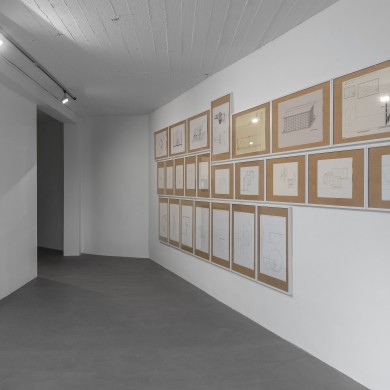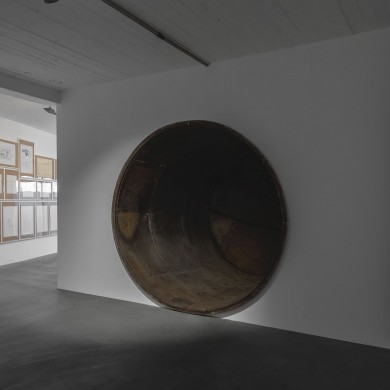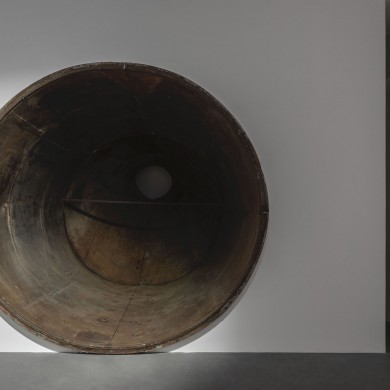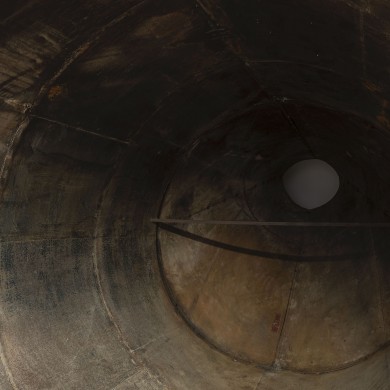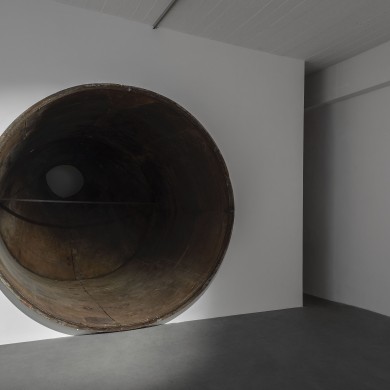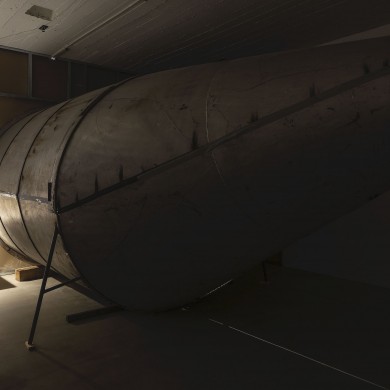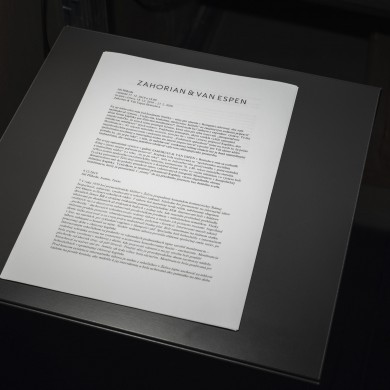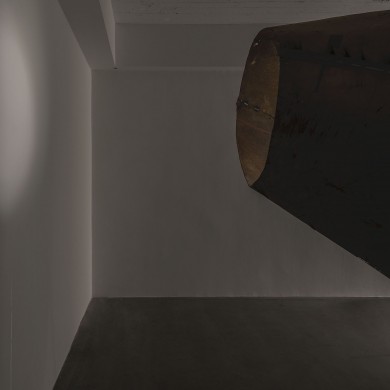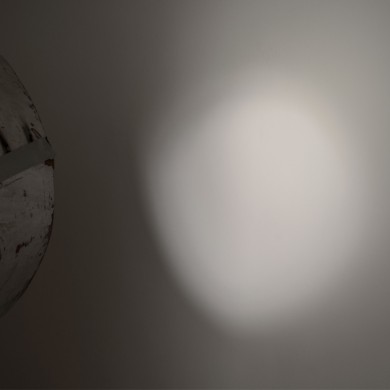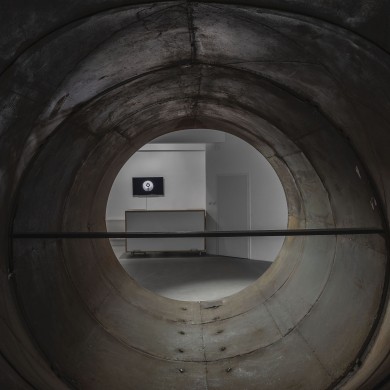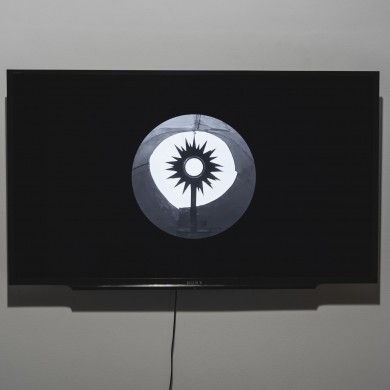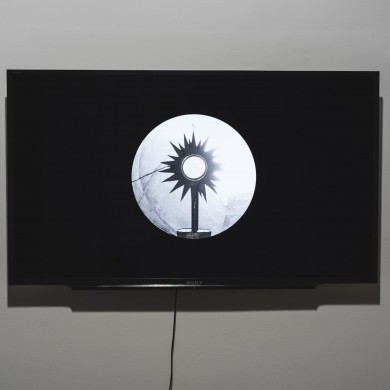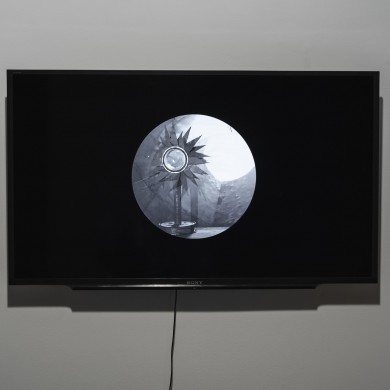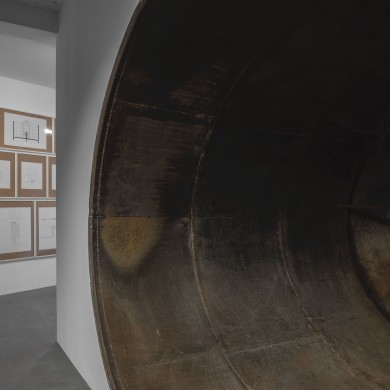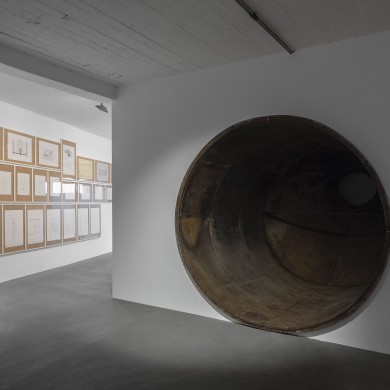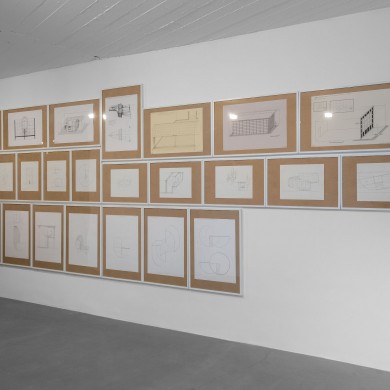Jiří Příhoda
18.12. 2019 – 27. 2. 2020
Zahorian & Van Espen Bratislava
Na jar tohto roku som bol kurátormi 8mičky – zóny pre umenie v Humpolci oslovený, aby som nainštaloval výstavu “Vrchovina, krabatina, mrchovina: Solitéři” so zaujímavým zadaním pripraviť akúsi formu kaplnky pre Želivskú monštranciu*, ktorá mala byť jedným z exponátov výstavy. To ma zaujalo natoľko, že som k tomu pristúpil formou, ktorú sám pre seba nazývam „interpretačnou inštaláciou artefaktov“ iných autorov. Podobným prístupom, akým vznikla vyššie zmienená Monštrancia v 50. rokoch minulého storočia, som pre ňu v rámci výstavy pripravil Kaplnku, ako najjednoduchšie pomenovanie vzniknutej situácie. „Podobným spôsobom“ mám na mysli to, že počas spoločensko-sociálnej a materiálnej núdze ste nútení improvizovať a použiť pre Váš zámer alebo potrebu to, „čo je po ruke“, s tým, že naliehavosť vzniknutej reálnej situácie nie je daná materiálnymi možnosťami, ale vnútornou potrebou odolávať vplyvom obklopujúceho prostredia.
Pre moju samostatnú výstavu v galérii ZAHORIAN & VAN ESPEN v Bratislave sme sa rozhodli ďalej s týmto mojim počinom pracovať…Kaplnka bola realizovaná zo “spoločensko-sociálnej a materiálnej núdze“ a z toho, „čo je po ruke“, teda zo železného sila, používaného v potravinárskej veľkovýrobni neskorého socialistického realizmu, komunizmu 70. a 80. rokov minulého storočia. Fyzická prítomnosť Želivskej monštrancie a skutočné denné svetlo vo vnútri inštalácie vo výstave boli dematerializované do podoby projekcie mnou vyhotovených fotografií Monštrancie v humpoleckej inštalácii Kaplnky. Výsledkom je spojenie prítomnosti Kaplnky verzus digitálneho obrazu monštrancie, ktorý je premietaný z „rozety“ do jej prázdneho priestoru bez denného svetla. (4.12.2019, Jiří Příhoda, Austin, Texas)
* V roku 1950 bol premonštrátsky kláštor v Želive prepadnutý komandom komunistickej Štátnej bezpečnosti, zabavený, vyrabovaný a rehoľníci zatknutí. Následne bol premenený na internačný tábor pre kňazov a členov rehoľných rádov. V tábore bol nastolený tvrdý režim, udržiavaný skupinou desiatich členov ŠtB a strážený tridsiatimi piatimi príslušníkmi SNB. Internovaní boli v kláštore ubytovaní po dvadsiatich až tridsiatich ľuďoch v jednej izbe, kde neustále prebiehali prehliadky osobných vecí a dozorcovia zabavovali predovšetkým predmety s náboženskou tematikou. Všetky „prehrešky“ duchovných vyhodnocovalo vedenie tábora a trestalo ich prísnymi trestami. Napríklad znížením prídelu potravín, obmedzovaním spánku, pobytom v korekcii. Internovaní museli taktiež denne ťažko pracovať a za svoju prácu nedostávali žiadny plat. Boli zamestnaní na štátnom statku, v lese, na stavbách, pri vykladaní vagónov v Humpolci atď. Spočiatku boli bohoslužby v internačnom tábore zakázané a konali sa tajne. Neskôr vedenie tábora povolilo slúženie spoločnej omše večer, po pracovnej dobe v chórovej kaplnke. Internovaným rehoľníkom sa podarilo vo väzenských podmienkach tajne vyrobiť monštranciu – ozdobnú schránku určenú na vystavenie a uctievanie konsekrovanej hostie – eucharistie. Monštrancia bola zrejme vyrobená v niektorej z dielní, kde pracovali väznení a na jej výrobu boli použité plechovky od uhoriek (troj- až päť-litrové). Použité sklo je pravdepodobne dnom zaváracej nádoby. Nezachoval sa uzáver ani tzv. lunula, ak teda vôbec bola súčasťou. Monštrancia bola používaná pri bohoslužbách v spomínanej chórovej kaplnke. Pred koncom existencie internačného tábora ju niekto z rehoľníkov v Želive tajne uschoval za tehlovú zástenu na povale kostola, aby nedošlo k jej znesväteniu a bola uchovaná ako pamiatka na túto dobu temna. Želivská monštrancia sa tak stala svedkom krutosti i nezlomenej nádeje. (Miloš Doležal, citované z katalógu výstavy Vrchovina, krabatina, mrchovina: Solitéri Vysočiny / Molds, Hills and Highlands: The Loners of Vysočina)
Jiří Příhoda (*1966, Česká republika) vyštudoval pražskú Akadémiu výtvarných umení (ateliér prof. Stanislava Kolíbala a prof. Aleša Veselého). Od roku 2011 žije a tvorí v Austine, Texas, USA a v Prahe. V roku 1997 bol ocenený Cenou Jindřicha Chalupeckého, v roku 2005 českou architektonickou Grand Prix a v roku 2014 cenou hlavného editora Designbloku. Samostatne vystavoval v galerii Nová síň (2016, 2018 společně s Brianem Eno), v Galerii Václava Špály v Prahe (1988), v Galerie A – 9 v MuseumsQuartier vo Viedni (2002), Moravskej galerii v Brne (2003), Hunt&Kastner Praha (2008, 2015 společně s Annou Hulačovou), v Galerii hlavního města Prahy (1995, 2016). Na skupinových výstavách sa predstavil v Museum of Modern Art v Paríži (1992), v Martin-Gropius-Bau v Berlíne (1994), v Museum of Contemporary Art v Helsinkách (1995), Kunsthalle Baden-Baden (1996), v Slovenskej národnej galérii (1998), Národní galerii v Prahe (2000), na Biennale Busan (2002), v Toloredo Art Institute (2005), PO SAMETU 20 let současného umění po roce 1989, Galerie hlavního města Prahy (2009), SOCHY V ULICÍCH Brno Art Open’11, Dům umění města Brna (2011, 2015) MEZI PRVNÍ A DRUHOU MODERNITOU, NG Praha, Muzeum moderního a současného umění, Veletržní palác, Nomadism and Design, Museum of Art, Seoul National University, Jižní Korea (2014), Dwelling Elsewhere (spoločne s Ma Qiusha, Xu Sheng) v Czech China Contemporary Art Museum v Pekingu, na VI. Biennale Gherdeina (2018).
Projekt podporil z verejných zdrojov Fond na podporu umenia ![]()
Jiří Příhoda
18 Dec 2019 – 27 Feb 2020
ZAHORIAN & VAN ESPEN Bratislava
In the Spring of this year I was invited by the curators of 8smicka Art Zone/ 8smicka Endowment Fund in Humpolec (Czech Republic) to contribute to the exhibition Molds, Hills and Highlands: The Loners of Vysočina, with the interesting assignment of preparing some sort of chapel for the Želiv Monstrance*, which was to be one of the exhibits. I found this so fascinating that I approached it in a manner for which my personal designation would be “interpretive installation of other artists’ artworks”. With an approach resembling that by which the Monstrance itself came into existence in the 1950s, for the exhibition I prepared a Chapel, which would be the simplest name for the situation that occurred. “With a similar approach”: what I mean is that in social and material deprivation you are forced to improvise and use for your purposes or needs “whatever is to hand”, so that the urgency of the real situation that has emerged is not defined by material possibilities but rather by the inner need to resist the influences of the surrounding environment.
For my solo exhibition in the ZAHORIAN & VAN ESPEN in Bratislava we have decided to continue working with this initiative of mine… the Chapel is still a work realised “in social and material deprivation” and from “whatever is to hand”, hence from the metal used in the mass production of processed food, in the later soc-realist style, by the communism of the 1970s and 80s. The physical presence of the Želiv Monstrance and the real daylight within the exhibition have been dematerialised to the form of a projection of photos of the Monstrance, taken by me in the Chapel installation at Humpolec. The result is a combination of the presence of the Chapel versus the digital image of the Monstrance, which is projected from a “rosette” into empty space without daylight. (4.12.2019, Jiří Příhoda, Austin, Texas)
* In 1950 the Premonstratensian Monastery in Želiv was raided by a commando of the communist State Security (StB), seized, plundered, and its monks interned. Eventually it was changed to an internment camp for priests and members of monastic orders. A harsh regime was established in the camp, which was run by a group of ten members of the StB and guarded by thirty five members of the SNB (National Security Corps). The internees were accommodated in the monastery with twenty or thirty persons to a room. There were constant searches of personal belongings, and the overseers made a point of seizing objects with a religious significance. All “infractions” by the clerics were assessed by the camp leadership and severely punished. The punishments included reduction of rations, limitation of sleep, and a spell in corrective detention. The internees were also required to work hard every day, without receiving any pay for their work. They were employed on a state farm, in forestry, on buildings, unloading wagons in Humpolec, and so on. Religious services were forbidden in the internment camp from the beginning; they were conducted in secret. Later the camp leadership allowed communal Masses to be held in the evenings after work, in the choir chapel. The interned monks managed, in the conditions of captivity, secretly to construct a monstrance ‒ a decorative box designed for display and worship of the Consecrated Host – for the Eucharist. The monstrance was apparently constructed in certain workshops where the internees were working, and cucumber tins (three to five litres) were used in its production. The glass used was probably from the bottom of a cooking vessel. The cap and the “lunula”, if in fact they formed parts of it, have not survived. The monstrance was used in religious worship in the above-mentioned choir chapel. Before the internment camp was closed down, one of the monks in Želiv secretly hid the monstrance behind a brick wall in the church grounds, so that it would not be desecrated and would be preserved as a memory of this dark time. The Želiv monstrance thus became a witness to cruelty and indomitable hope. (Miloš Doležal, cited from the exhibition catalogue Molds, Hills and Highlands: The Loners of Vysočina)
Jiří Příhoda (*1966, Czech Republic) studied at the Academy of Fine Arts in Prague (studio of prof. Stanislav Kolíbal and prof. Aleš Veselý). Since 2011 lives and works in Austin and Prague. In 1997 he was awarded the Jindřich Chalupecký Award, in 2005 Czech Architectural Grand Prix and in 2014 the Designblok Cheif editor’s Award. He exhibited at the Gallery Nova Sin (2016, 2018 together with Brian Eno), Václav Špála Gallery in Prague (1998), Gallery A8, MuseumQuartier (2002), Hunt&Kastner Prague (2008, 2015 together with Anna Hulacova), at the Prague City Gallery (1995, 2016) and mPOD (together with Tomáš Moravec) at the Czech China Contemporary Art Museum in Peking. He also participated at group exhibitions at Museum of Modern Art in Paris (1992), Martin-Gropius-Bau in Berlin (1994), Museum of Contemporary Art in Helsinki (1995), Kunsthalle Baden-Baden (1996), Slovak National Gallery (1998), National Gallery in Prague (2000), Biennale Busan (2002), Toloredo Art Institute (2005), AFTER VELVET, Czech Art after 1989, Collection of Czech Contemporary Art, Prague City Gallery, House at the Golden Ring (2009), BRNO ART OPEN – 2011, Art in public space, House of Arts Brno, Czech Rep. (2011 , 2015), Between first and second modernity, Czech Art from 1980 till 2010, National Gallery Prague (2012), Nomadism and Design, Museum of Art, Seoul National University, South Korea (2014), Dwelling Elsewhere (with Ma Qiusha, Xu Sheng), Czech China Contemporary Art Museum Peking (2018), at the VI. Biennale Gherdeina (2018).
exhibition view: Marko Horban
